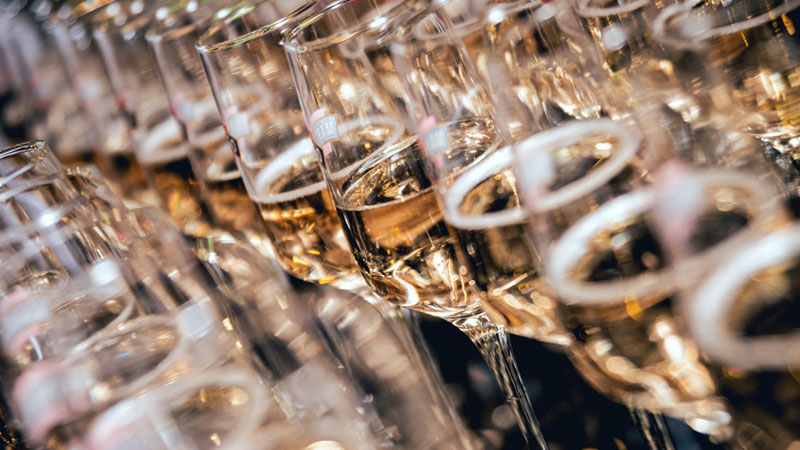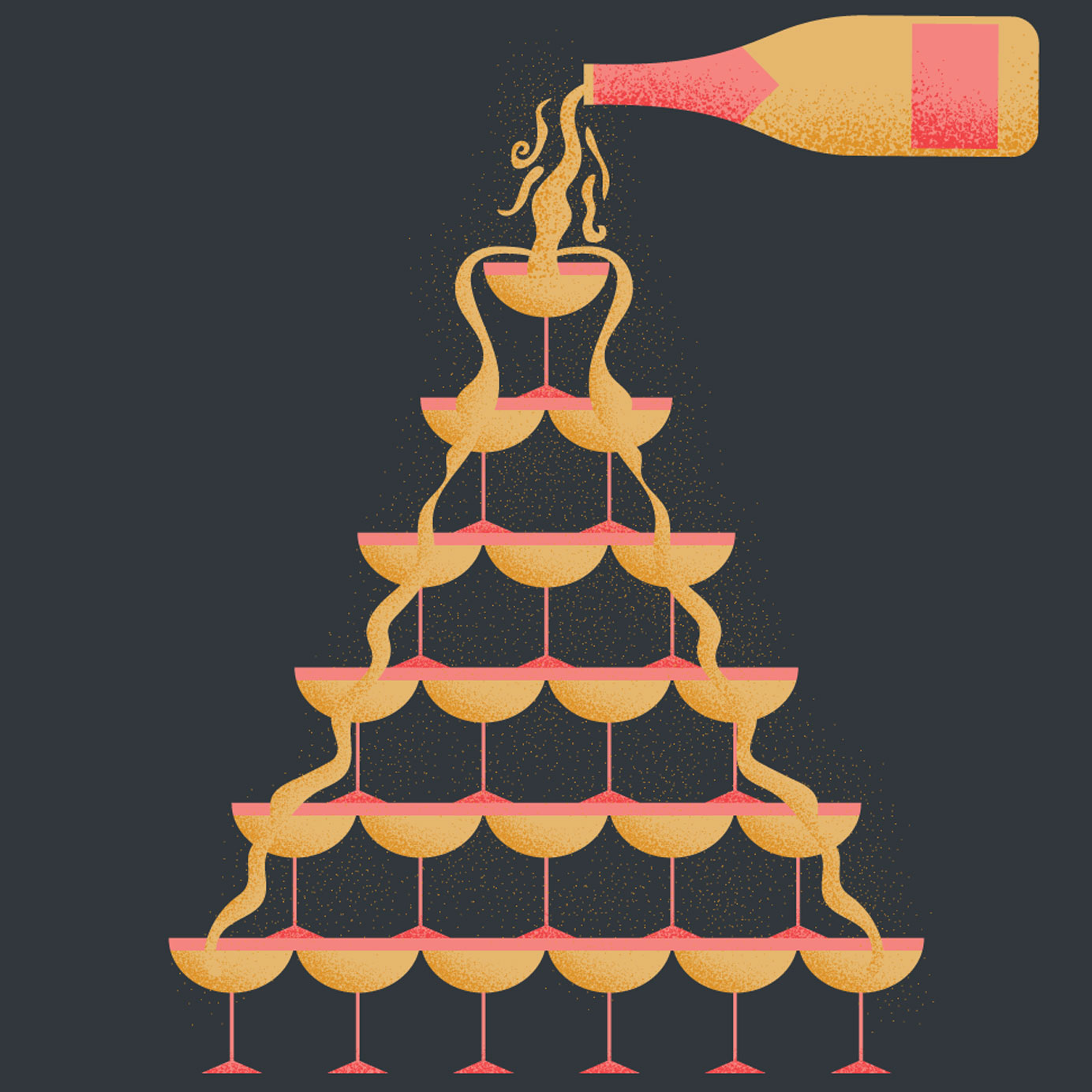“Sugar is like butter on meat,” Matteo Burani, export manager for Italy’s Gruppo Lunelli, says. He’s not talking about cooking, though; Burani is referring to the effect of dosage, or added sugar, in sparkling winemaking. Sugar might complement existing flavors, Burani says, but it can also mask what you’re tasting.
Gruppo Lunelli’s Ferrari Trento label is among a handful of producers at the forefront of the low- and no-dosage movement, a trend of making sparkling wines with minimal or zero added sugar. It’s a tricky landscape to navigate. No-dosage Champagne first debuted in 1889, but for many consumers and winemakers, the style remains on the fringe.
Now, a small group of savvy wine professionals is celebrating low- and no-dosage sparklers hailing from France, Italy, Germany, and beyond. These wines check a lot of boxes for contemporary consumers, appealing to low-interventionalists and the Whole 30 set in equal measure.
Yet there is more to low- and no-dosage wines than reduced calories or health halos. According to many wine pros, low- and no-dosage wines might just be the purest example of terroir a sparkling house can offer.
Name Game
In simple terms, there are a few ingredients that typically go into a sparkling wine: grapes, yeast, and sugar. The last part comprises dosage and is usually “a blend of wine and sugar syrup or concentrated grape juice, intended to balance out the Champagne, which may otherwise be highly acidic and severely dry,” writes The New York Times’s Eric Asimov.
Sparkling wines are classified by their sweet-to-dry profile. The most popular style of Champagne today is brut, which has up to 12 grams of residual sugar (RS) per liter. The next driest tier is extra brut, also known as low dosage, with six grams of RS per liter. Wines with 3 grams of sugar or less per liter are called brut nature, brut zéro, non-dosé, or low- or no-dosage.
Taste and Technique
Traditionally, sugar serves as a tool to soften acidity in winemaking. Why would any winemaker want to remove it?
By choosing to forgo dosage, you can get an “honest terroir expression,” Vanessa Price of Maisons Marques & Domaines says. “You are left with a wine that is a much purer expression of Champagne terroir than we typically find due to the lack of layered imprints that are traditional in the way Champagne is made.”
Ryan White, beverage director at Manhattan luxury building 432 Park Avenue, agrees. “Zéro dosage Champagne was pioneered, and is being driven still today, by winemakers who wish to showcase their vineyards’ individual terroir and unique qualities and attributes over that of homogenous flavor,” White says. “Reducing, or in some cases outright eliminating, the final addition of sugar to the wines in bottle better guarantees that those crisp, sharp, racy, linear, vinous aromas and flavors will not be masked or lost.”
In other words, to continue Burani’s analogy, these steaks taste like steak, not like butter.
Admittedly, reduced sugar content also gives low- and no-dosage wines practical allure. Americans have struggled in recent years to define what, exactly, is healthy — from low fat to high protein to South Beach to paleo, we’ve tried it all. Cutting out sugar is part of popular regimes like Whole 30 and strikes many as a fairly foolproof way to mind their diets.
Blaine Ashley of New York Champagne Week and Pompette, a New York-based wine and spirits-centric events company, says this aspect of low- and no-dosage wines is only part of their appeal. “My palate has personally always leaned toward drier extra brut and brut zéro wines,” Ashley says, “I believe that lower dosage provides a purer expression of fruit, and society is moving toward less sugar in general with a boost in the organic food movement and dilution of soda-drinking culture.”
Producing well-rounded, low-dosage bubbles takes considerable skill. Winemakers have to pick phenologically riper fruit, co-harvest and ferment all the varietals, block malolactic fermentation, and lessen the pressure, Price says.
“The lack of extra sugar allows the character of the vineyard and the vintage to take center stage. In short, these wines are transparent, austere in their youth, and they stand in bold contrast to the traditional practices of assemblage in Champagne,” White says.
Widespread Appeal
Champagne and other sparkling wines are famously food-friendly; less sugar makes them even more so.
Matteo Lunelli, president and CEO of Ferrari Fratelli Lunelli S.p.A., has been in the no dosage game for years. Ferrari’s Perlé Zero is “a wine that can pair perfectly with food — obviously, when you pair wine with food, sugar is not usually very welcome, especially at the dinner table,” Lunelli says. He thinks risotto with salty, Grana Padano-esque cheese would work beautifully with his no-dosage bottle. “The wine’s acidity and sharpness can balance well, for example, some dishes that have a stronger element of fat,” he says.
Low- and no-dosage wines can also help democratize sparkling wines for broader audiences, according to Ashtin Berry, a wine and bar professional and activist who has worked at Air’s Champagne Bar and Tokyo Record Bar in NYC and the Ace Hotel New Orleans, among others. The naming conventions of Champagne and sparkling wines can easily alienate those who are either new to the category or unfamiliar with French.
“‘Extra brut’ can looks scary to some people,” Berry says. Low- and no-dosage wines span global wine regions, are instantly recognizable, and accessible “to those not familiar with terminology like brut,” Berry says.
Going Places
In terms of everyday consumption, low- and no-dosage wines are poised to rise in popularity. The category includes a number of affordable options, produced everywhere from Champagne to Germany to California. (In Italy, the Prosecco DOCG is putting an “extra brut” classification into place in the next few months; qualifying bottles will fall between no-dosage and brut on the dryness spectrum.)
“I think they are becoming more relevant for the consumer,” Price says. “I can confidently say more and more drinkers will look to these as an alternative to the classic bruts as more people are exposed to the style. I don’t think it’s going anywhere anytime soon.”

Seven Low- and No-Dosage Sparkling Wines to Try
Here is a comprehensive list of low- and no-dosage wines to try right now, from Champagne and beyond, as recommended by the experts.
Dr. Deinhard Riesling Sekt Extra Brut
Though she describes herself as a “Champagne fiend,” Ashtin Berry’s favorite non-dosage bubbles bring her elsewhere on the map. “German wine regions like Pfalz and Mosel are producing some of my favorite sparkling wines right now,” Berry says. “Dr. Deinhard is an extra brut Riesling and it is delicious.” Average price: $25.
Vouette et Sorbée “Textures” Brut Nature
Doreen Winkler, a German-born, New York-based sommelier and consultant specializing in natural wines, recommends this biodynamic grower Champagne made from Pinot Blanc, which, according to Winkler, makes up just 1 percent of Champagne grape production. “I would describe it as ‘texturous’ with aroma of apple, pear, white peach, and raw almond,” Winkler says. The ethos of natural wines, usually known for their distinct element of funk, goes hand-in-hand with the concept of minimal or no dosage, together allowing the liquid’s true nature to shine. Average price: $127.
Louis Roederer Brut Nature 2009
This French producer has the largest biodynamic operation in the Champagne region, and the Brut Nature has a distinctly terroir-driven profile, according to Vanessa Price. “I also love that Philippe Starck designed the labels — it’s an atypical Champagne with an atypical label!” Price says. Bottle aside, this is a special wine, the product of an extraordinary year for Champagne. It is bright and creamy, with strong floral and chestnut notes. Average price: $85.
2017 Finke’s Sparkling White Blend
Low- and no-dosage sparkling wines happen to be a personal preference of Brooke Mathias, wine director of Winc, the subscription-based wine club. “I love that Finke’s is refreshing and has the celebratory feel of Champagne without the price tag,” she says of this Chardonnay-Chenin Blanc blend bottled exclusively for the platform’s members. “The wine also has tropical fruit flavors that shine through, and it pairs well with a variety of festive dishes now that the holidays are upon us.” Average price: $13 (must have Winc membership to buy).
Champagne Henriot Cuvée Hemera 2005
“This Champagne is made up of 50 percent Chardonnay and 50 percent Pinot Noir, 100 percent of which comes from grand cru vineyards, and is aged 12 years on the lees,” Blaine Ashley says. “The result is a flavor of fresh candied citrus and honey that lingers into a long, toasty finish.” Average price: $189.99.
Ca’ del Bosco Cuvée Anna Clementi 2008
“I’m really digging Franciacorta right now,” Ashley says of the Italian sparkling wine hailing from the Brescia province within Lombardy. Franciacorta has had DOCG status since the early 1960s. “I recently had the chance to taste [a great] zero dosage cuvée by Ca’ del Bosco — the entire range is actually low dosage. This particular cuvée is supremely special as it’s aged a minimum of seven to nine years on the lees!” Ashley says. Average price: $79.
Domaine Trimbach ‘Cuvée Frédéric Emile’ Riesling
This dry Riesling has less than four grams RS and is a good counterpoint for people who say, “I hate Riesling because they’re all sweet.” “The grapes are sourced from two grand cru vineyards on a single hillside directly behind the Trimbach estate,” Ryan Baldwin, sommelier of Margeaux Brasserie at Chicago’s Waldorf Astoria, says, praising its high-acid complexity. Much like Berry’s Dr. Deinhard recommendation, the Cuvée Frédéric Emile is a surprising departure from what we think of when we hear the word “Riesling.” Average price: $69.
